Nuts are a nutritious and delicious snack that many adults enjoy. They are packed with healthy fats, protein, and other essential nutrients, making them a great addition to any diet. However, parents often wonder when it’s safe for their kids to start eating nuts. The answer is not straightforward, as there are many factors to consider when introducing nuts to children. In this article, we’ll explore the benefits and risks of nuts for kids and provide guidance on how to safely incorporate them into your child’s diet.
When is it Safe for Kids to Eat Nuts?
The American Academy of Pediatrics (AAP) recommends that parents wait until their child is at least two years old before introducing nuts into their diet. This is because nuts are a common allergen, and young children are at a higher risk of developing a severe allergic reaction. Additionally, whole nuts can be a choking hazard for younger children.
However, recent research suggests that introducing nuts to children at a younger age may actually reduce their risk of developing a nut allergy. The Learning Early About Peanut Allergy (LEAP) study found that children who were fed peanut products from an early age had a significantly lower risk of developing a peanut allergy compared to those who avoided peanuts altogether.
Ultimately, the decision to introduce nuts to your child’s diet should be made in consultation with their pediatrician. Your child’s doctor can help you assess your child’s individual risk factors and provide guidance on when and how to introduce nuts safely.
Nuts and Kids: What Every Parent Needs to Know
If you’re considering introducing nuts to your child’s diet, there are a few things you should keep in mind:
- Start with small amounts: When introducing nuts to your child, start with a small amount and watch for any signs of an allergic reaction. If your child tolerates the nuts well, you can gradually increase the amount over time.
- Choose the right nut: Some nuts are more allergenic than others. Peanuts, tree nuts, and seeds are the most common allergenic nuts. If your child has a family history of nut allergies, it may be best to avoid these nuts altogether.
- Avoid whole nuts: Whole nuts can be a choking hazard for young children. Instead, offer nut butters or finely chopped nuts.
- Watch for signs of an allergic reaction: Symptoms of a nut allergy can include hives, swelling, difficulty breathing, and gastrointestinal distress. If your child experiences any of these symptoms after eating nuts, seek medical attention immediately.
- Be patient: It may take some time for your child to get used to the taste and texture of nuts. Offer them in a variety of forms, such as nut butters, chopped nuts, or mixed into other foods like yogurt or oatmeal.
Introducing Nuts to Your Child: A Guide for Parents
If you’re ready to introduce nuts to your child’s diet, here are some tips to help make the process as smooth and safe as possible:
- Talk to your child’s pediatrician: Before introducing nuts to your child, talk to their pediatrician. They can help you assess your child’s individual risk factors and provide guidance on how to safely introduce nuts into their diet.
- Choose the right time: Make sure your child is in good health and not experiencing any allergic reactions or other medical issues when you introduce nuts to their diet.
- Start with a small amount: Begin by offering your child a small amount of finely chopped nuts or nut butter. Watch for any signs of an allergic reaction, such as hives, swelling, difficulty breathing, or gastrointestinal distress.
- Gradually increase the amount: If your child tolerates the nuts well, gradually increase the amount over time. This will help their body adjust to the new food and reduce the risk of an allergic reaction.
- Offer a variety of nuts: Nuts come in many different varieties, each with its own unique taste and texture. Offer a variety of nuts to your child to help them find the ones they like best.
- Incorporate nuts into meals and snacks: Nuts can be a great addition to meals and snacks. Try adding them to oatmeal, yogurt, smoothies, or trail mix.
- Be patient: It may take some time for your child to get used to the taste and texture of nuts. Keep offering them in a variety of forms and be patient as your child learns to enjoy them.
The Benefits and Risks of Nuts for Children
Nuts are a great source of nutrition for children. They are packed with healthy fats, protein, fiber, and other essential nutrients. Here are some of the benefits of nuts for kids:
- Improved heart health: Nuts are high in healthy fats, which can help improve cholesterol levels and reduce the risk of heart disease.
- Better brain function: Nuts are a great source of omega-3 fatty acids, which are essential for brain development and function.
- Increased satiety: Nuts are a filling snack that can help kids feel full and satisfied between meals.
- Reduced risk of obesity: Nuts are a nutrient-dense snack that can help kids maintain a healthy weight.
However, there are also some risks associated with nuts for children. As we mentioned earlier, nuts are a common allergen, and some children may develop a severe allergic reaction. Additionally, nuts can be a choking hazard for younger children.
To minimize the risk of an allergic reaction, parents should start with small amounts of nuts and watch for any signs of a reaction. If your child has a family history of nut allergies, it may be best to avoid nuts altogether.
To reduce the risk of choking, parents should avoid offering whole nuts to young children. Instead, offer nut butters or finely chopped nuts.

Nuts for Kids: How to Safely Incorporate Them into Their Diet
If you’re looking for ways to incorporate nuts into your child’s diet, here are some ideas:
- Nut butters: Nut butters are a great way to introduce kids to the taste and texture of nuts. Try spreading peanut butter or almond butter on toast, crackers, or fruit.
- Trail mix: Trail mix is a fun and easy snack that kids can take on-the-go. Combine nuts with dried fruit, seeds, and whole-grain cereal for a tasty and nutritious snack.
- Homemade granola bars: Granola bars are a great way to sneak nuts into your child’s diet. Try making your own granola bars with nuts, seeds, and dried fruit.
- Smoothies: Smoothies are a great way to sneak in some extra nutrition. Try adding a handful of nuts to your child’s favorite smoothie recipe for a boost of protein and healthy fats.
- Nutty desserts: Nuts can also be a delicious addition to desserts. Try making nutty cookies, brownies, or cakes for a tasty and nutritious treat.
Conclusion
Nuts are a nutritious and delicious snack that can be a great addition to a child’s diet. However, parents need to be aware of the potential risks associated with nut allergies and choking hazards. By following the tips we provided above and introducing nuts to your child’s diet in a safe and gradual manner, you can help them enjoy the many benefits of this nutrient-dense food.
Remember to always consult with your child’s pediatrician before introducing new foods to their diet, especially if they have a history of food allergies or medical issues. With a little patience and creativity, you can help your child develop a healthy and varied diet that includes nuts and other nutritious foods.
